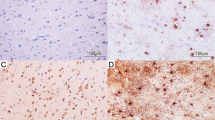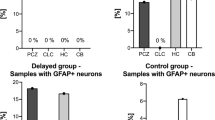Abstract
To establish reliable methods to aid the timing of brain damage after traumatic brain injury (TBI), brain tissue from 56 autopsy cases with TBI and known survival times, ranging from a few minutes to 126 days, were tested for apoptotic changes to the neuronal and glial cells. Apoptosis was established using the TdT-mediated dUTP nick end labelling (TUNEL) method of in-situ labelling and immunohistochemical reaction of caspase 3. In addition, cellular reaction and astroglial cell differentiation were investigated using histological and immunohistochemical markers. From a survival time of 120 min up to 12 days, TUNEL-positive apoptotic neuronal cells were frequently detected in the contusion zone. The earliest positive caspase 3 reaction in cortical neurons was evident after a posttraumatic interval of 80 min. Detection of apoptotic glial cells using the TUNEL technique showed that as in the case of neuronal cells, the earliest positive TUNEL reaction was obtained after 110 min. In cases of survival times of 120 min up to 4 days, apoptotic glial cells could frequently be detected. However, the first caspase 3-positive glial cells appeared 5 h after injury. Cerebral apoptosis was significantly associated with TBI cases as compared to control cases (P<0.001). The reference histological findings of neutrophilic granulocytes, CD3-positive T-lymphocytes, CD68-positive activated microglial cells/macrophages and TUNEL-positive neuronal cells increases the degree of certainty in determining the probable age of traumatic brain injury to 87.5%.




Similar content being viewed by others
References
Ng I, Yeo TT, Tang WY, Soong R, Ng PY, Smith DR (2000) Apoptosis occurs after cerebral contusions in humans. Neurosurgery 46:949–956
Padosch SH, Vogel P, Böttiger BW (2001) Neuronale Apoptose nach zerebraler Ischämie. Anaesthesist 50:905–920
Raghupathi R, Graham DI, Mcintosh TK (2000) Apoptosis after traumatic brain injury. J Neurotrauma 17:927–938
Springer JE, Nottingham SA, Mcewen ML, Azbill RD, Jin Y (2001) Caspase-3 apoptotic signalling following injury to the central nervous system. Clin Chem Lab Med 39:299–307
Suzuki A, Shiraki K (2001) Tumor cell “dead or alive”: caspase and surviving regulate cell death, cell cycle and cell survival. Histol Histopathol 16:583–593
Ridout HJ, Stefenis L (2001) Caspase inhibitation. A potential therapeutic strategy in neurological diseases. Histol Histopathol 16:895–908
Yakovlev AG, Faden AI (2001) Caspase dependent apoptotic pathways in CNS injury. Mol Neurobiol 24:131–144
Kam PCA, Ferch NI (2000) Apoptosis: mechanisms and clinical implications. Anaesthesia 55:1081–1093
Lewen A, Matz P, Chan PH (2000) Free radical pathways in CNS injury. J Neurotrauma 17:871–890
Oehmichen M (2001) Brain hypoxia and ischemia. Schmidt-Römhild, Lübeck
Eldadah BA, Faden AI (2000) Caspase pathways, neuronal apoptosis, and CNS injury. J Neurotrauma 17:811–829
Harter L, Keel M, Hentze H, Leist M, Ertel W (2001) Caspase-3 activity is present in cerebrospinal fluid from patients with traumatic brain injury. J Neuroimmunol 121:76–78
Fisher LD, van Belle G (1993) Biostatistics—a methodology for the health sciences. Wiley, New York
Oehmichen M (1990) Die Wundheilung. Springer, Berlin Heidelberg New York
Hausmann R, Kaiser A, Lang C, Bohnert M, Betz P (1999) A quantitative immunohistochemical study on the time-dependent course of acute inflammatory cellular response to human brain injury. Int J Legal Med 112:227–232
Hausmann R, Betz P (2000) The time course of the vascular response to human brain injury—an immunohistochemical study. Int J Legal Med 113:288–292
Hausmann R, Betz P (2001) Course of glial immunoreactivity for vimentin, tenascin and α1 antichymotrypsin after traumatic injury of human brain. Int J Legal Med 114:338–342
Crooks DA, Scholtz CL, Vowles G, Greenwald S, Evans S (1991) The glial reaction in closed head injuries. Neuropathol Appl Neurobiol 17:407–414
Hausmann R, Riess R, Fieguth A, Betz P (2000) Immunohistochemical investigations on the course of astroglial GFAP expression following human brain injury. Int J Legal Med 113:70–75
Onaya M (2002) Neuropathological investigation of cerebral white matter lesions caused by closed head injury. Neuropathology 22:243–251
Williams S, Raghupathi R, Mackinnon MA, Mcintosh TK, Saatman KE, Graham DI (2001) In situ DNA fragmentation occurs in white matter up to 12 months after head injury in man. Acta Neuropathol 102:581–590
Hausmann R, Biermann T, Wiest I, Tübel J, Betz P (2004) Neuronal apoptosis following human brain injury. Int J Legal Med 118:32–36
Dressler J, Hanisch U, Busuttil A (2005) Comments on Hausmann et al: neuronal apoptosis following human brain injury. Int J Legal Med 119:177–178
Ang BT, Yap E, Lim J, Tan WL, Ng PY, Ng I, Yeo TT (2003) Poly(adenosine diphosphate-ribose) polymerase expression in human traumatic brain injury. J Neurosurg 99:125–130
Raghupathi R (2004) Cell death mechanisms following traumatic brain injury. Brain Pathol 14:215–222
Giffard R, Ouyang Y (2004) Effect of overexpression of protective genes on mitochondrial function of stressed astrocytes. J Bioenerg Biomembr 36:313–315
Hostettler ME, Knapp PE, Carlson SL (2002) Platelet-activating factor induces cell death in cultured astrocytes and oligodendrocytes: involvement of caspase-3. Glia 38:228–239
Bonini P, Cicconi S, Cardinale A, Vitale C, Serafino AL, Ciotti MT, Marlier LN (2004) Oxidative stress induces p53-mediated apoptosis in glia: p53 transcription-independent way to die. J Neurosci Res 75:83–95
Hausmann R, Vogel C, Seidel S, Betz P (2006) Value of morphological parameters for grading of brain swelling. Int J Legal Med 120:219–225
Rohn TT, Head E, Su JH, Anderson AJ, Bahr BA, Cotmann CW, Cribbs DH (2001) Correlation between caspase activation and neurofibrillary tangle formation in Alzheimer’s disease. Am J Pathol 158:189–198
Hartmann A, Hunot S, Michel PP et al (2000) Caspase-3: a vulnerability factor and final effector in apoptotic death of dopaminergic neurons in Parkinson’s disease. Proc Natl Acad Sci USA 97:2875–2880
Fowler J, Mackinnon MA, Raghupathi R, Saatman KE, Mcintosh TK, Graham DI (2002) Age does not influence DNA fragmentation in the hippocampus after fatal traumatic brain injury in young and aged humans compared with controls. Clin Neuropathol 21:156–162
Witeside G, Cougnon N, Hunt SP, Munglani R (1998) An improved method for detection of apoptosis in tissue sections and cell culture, using the TUNEL technique combined with Hoechst stain. Brain Res Brain Res Protoc 2:160–164
Davison FD, Groves M, Scaravilli F (1995) The effects of formalin fixation on the detection of apoptosis in human brain by in-situ end-labelling of DNA. Histochem J 12:983–988
Schallock K, Schulz-Schaefer WJ, Giese A, Kretzschmar HA (1997) Postmortem delay and temperature conditions affect the in situ end-labeling (ISEL) assay in brain tissue of mice. Clin Neuropathol 16:133–136
Geiger KD, Bloom FE, Sarvetnick NE (1997) Methods for the detection of apoptosis in the CNS. In: Poirier J (ed) Neuromethods apoptosis techniques and protocols. Humana 29, Totowa, NJ, pp 217–235
Hummel K, Ihm P, Schmidt V (1972) Biostatistische Abstammungsbegutachtung. Tabellenwerk. Fischer, Stuttgart
Dressler J, Koch R, Bachmann L, Müller E (1998) Modell zur Schätzung des Wundalters mit Hilfe des Expressionsgrades von Adhäsionsmolekülen. Rechtsmedizin 8[Suppl I]:A 25
Acknowledgement
We wish to thank Doreen Kuechler for the excellent technical assistance.
Author information
Authors and Affiliations
Corresponding author
Rights and permissions
About this article
Cite this article
Dreßler, J., Hanisch, U., Kuhlisch, E. et al. Neuronal and glial apoptosis in human traumatic brain injury. Int J Legal Med 121, 365–375 (2007). https://doi.org/10.1007/s00414-006-0126-6
Received:
Accepted:
Published:
Issue Date:
DOI: https://doi.org/10.1007/s00414-006-0126-6




